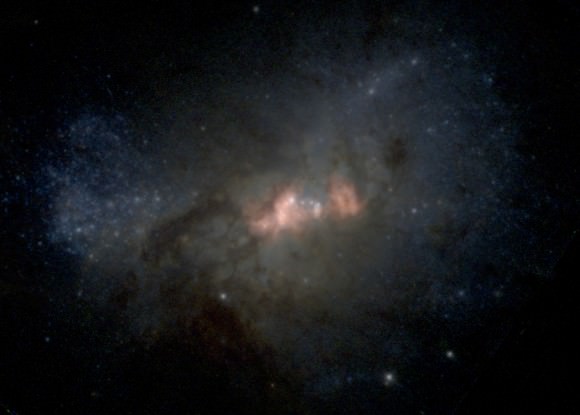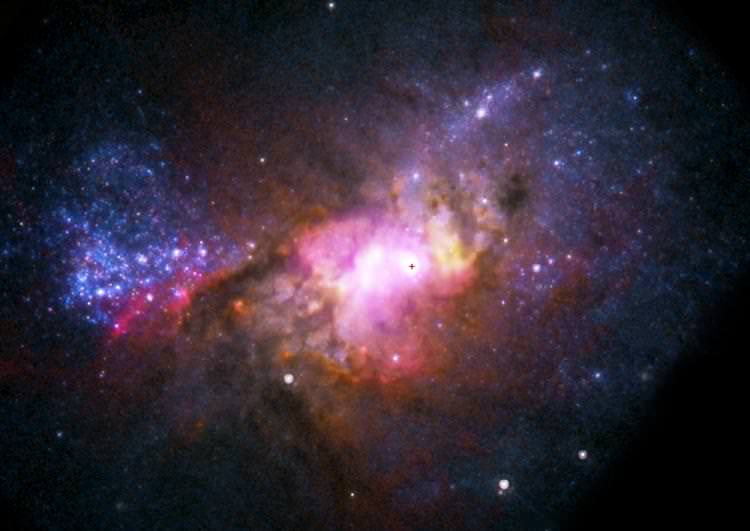[/caption]
It’s a bird… It’s a plane… It’s a million times more massive than our Sun! Just how big do you have to be to hide something really big? Well, in the case of a supermassive black hole all you have to be is a small galaxy.
According to the American Astronomical Society Press Release the surprising discovery of a supermassive black hole in a small nearby galaxy has given astronomers a tantalizing look at how black holes and galaxies may have grown in the early history of the Universe. Finding a black hole a million times more massive than the Sun in a star-forming dwarf galaxy isn’t exactly child’s play – but it is a strong indication that supermassive black holes formed before the buildup of galaxies.
So what’s its name? The big little galaxy is called Henize 2-10. Located 30 million light-years from Earth, it’s not unknown to astonomers and is noted for rapid star formation. This irregular player is roughly 3% the size of the Milky Way and scientists think it may greatly resemble some of the first galaxies for form in the early Universe. “This galaxy gives us important clues about a very early phase of galaxy evolution that has not been observed before,” said Amy Reines, a Ph.D. candidate at the University of Virginia.
We’ve been aware for some time that supermassive black holes are present in the cores of all “full-sized” galaxies – however, we’re a bit more used to balancing the scale. In the nearby Universe, there is a direct relationship — a constant ratio — between the masses of the black holes and that of the central “bulges” of the galaxies, leading them to conclude that the black holes and bulges affected each others’ growth.
Two years ago, an international team of astronomers found that black holes in young galaxies in the early Universe were more massive than this ratio would indicate…

“Now, we have found a dwarf galaxy with no bulge at all, yet it has a supermassive black hole. This greatly strengthens the case for the black holes developing first, before the galaxy’s bulge is formed,” Reines said. She, along with Gregory Sivakoff and Kelsey Johnson of the University of Virginia and the National Radio Astronomy Observatory (NRAO), and Crystal Brogan of the NRAO, observed Henize 2-10 with the National Science Foundation’s Very Large Array radio telescope and with the inquisitive eye of the Hubble Space Telescope. What did they find hiding behind the neighbor’s hedges? How about a region near the center of the galaxy that strongly emits radio waves with characteristics of those emitted by super-fast “jets” of material spewed outward from areas close to a black hole. A concept we’ve come quite familiar with in recent years!
Next up, they then searched images from the Chandra X-Ray Observatory that showed this same, radio-bright region to be strongly emitting energetic X-rays. This combination, they said, indicates an active, black-hole-powered, galactic nucleus. “Not many dwarf galaxies are known to have massive black holes,” Sivakoff said.
Of course, there are central black holes of roughly the same mass as the one in Henize 2-10 have been found in other galaxies, those galaxies all have much more regular shapes – the “normal” kids of the hood. Henize 2-10 differs not only in its irregular shape and small size but also in its furious star formation, concentrated in numerous, very dense super star clusters. “This galaxy probably resembles those in the very young Universe, when galaxies were just starting to form and were colliding frequently. All its properties, including the supermassive black hole, are giving us important new clues about how these black holes and galaxies formed at that time,” Johnson said.
Kids… Gotta’ love ’em!
CREDIT: Reines, et al., David Nidever, NRAO/AUI/NSF, NASA


Irregular shape, high star formation rate and SMBH in the center – maybe that’s a remnant of a bigger galaxy that somehow did not merge with the other one (if there is one) but left most of it’s material and flown away?
Gravity tends to clump things, so it is likely this is true to its original state.
LC
“The big little galaxy is called Henize 2-10.”
You’ve missed some vital points here.
He2-10 or HEN 2-10, also catalogued as ESO 495-21 or PGC 24176, and was once thought to be a planetary nebula. It was discovered by American-born astronomer, and later astronaut, Karl Henize in 1966, who was doing his southern deep-sky survey in Hydrogen-alpha light achieved from Mt. Stromlo observatory near Canberra. It was found by Allen in 1976 to be an active dwarf emission line galaxy and also the first extragalactic galaxy to have direct evidence of Wolf-Rayet stars. It was first radio mapped ay 5GHz by Zijstra et.al. in 1990.
This fairly bright 12.4p galaxy lies in the southern constellation of Pyxis, appearing as some 1.7×1.3 arcmin in size. Visually has a stellar-like core that is visible in 15cm (6-inch) telescopes. Its position is 08h 36.3m ?26º 25′ (2000)
Distance is 15.7±1.1 Mpc. (against the cosmic background radiation) from the radial velocity of 1150±19 km.s^-1. This makes the distance of this galaxy more like 50 million light years (actually 51.2±3.6 million light-year) than 30 million light years.
I really like the part about… “characteristics of those emitted by super-fast “jets” of material spewed outward from areas close to a black hole.” The gamma ray halo/bubble’s recently discovered above and below the plane of the Milky Way Galaxy come to mind…